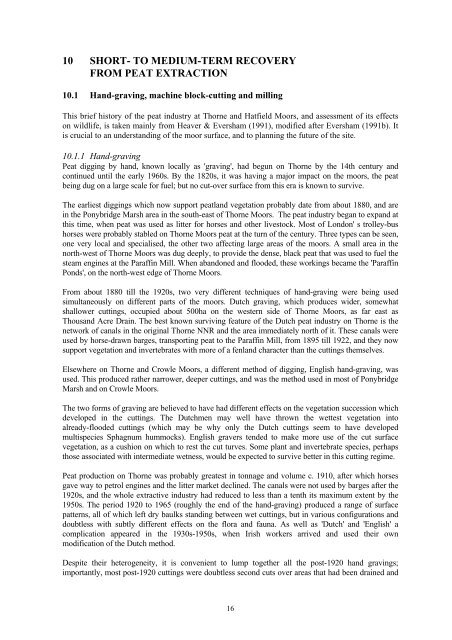free download - Thorne & Hatfield Conservation Forum
free download - Thorne & Hatfield Conservation Forum
free download - Thorne & Hatfield Conservation Forum
You also want an ePaper? Increase the reach of your titles
YUMPU automatically turns print PDFs into web optimized ePapers that Google loves.
10 SHORT- TO MEDIUM-TERM RECOVERY<br />
FROM PEAT EXTRACTION<br />
10.1 Hand-graving, machine block-cutting and milling<br />
This brief history of the peat industry at <strong>Thorne</strong> and <strong>Hatfield</strong> Moors, and assessment of its effects<br />
on wildlife, is taken mainly from Heaver & Eversham (1991), modified after Eversham (1991b). It<br />
is crucial to an understanding of the moor surface, and to planning the future of the site.<br />
10.1.1 Hand-graving<br />
Peat digging by hand, known locally as 'graving', had begun on <strong>Thorne</strong> by the 14th century and<br />
continued until the early 1960s. By the 1820s, it was having a major impact on the moors, the peat<br />
being dug on a large scale for fuel; but no cut-over surface from this era is known to survive.<br />
The earliest diggings which now support peatland vegetation probably date from about 1880, and are<br />
in the Ponybridge Marsh area in the south-east of <strong>Thorne</strong> Moors. The peat industry began to expand at<br />
this time, when peat was used as litter for horses and other livestock. Most of London' s trolley-bus<br />
horses were probably stabled on <strong>Thorne</strong> Moors peat at the turn of the century. Three types can be seen,<br />
one very local and specialised, the other two affecting large areas of the moors. A small area in the<br />
north-west of <strong>Thorne</strong> Moors was dug deeply, to provide the dense, black peat that was used to fuel the<br />
steam engines at the Paraffin Mill. When abandoned and flooded, these workings became the 'Paraffin<br />
Ponds', on the north-west edge of <strong>Thorne</strong> Moors.<br />
From about 1880 till the 1920s, two very different techniques of hand-graving were being used<br />
simultaneously on different parts of the moors. Dutch graving, which produces wider, somewhat<br />
shallower cuttings, occupied about 500ha on the western side of <strong>Thorne</strong> Moors, as far east as<br />
Thousand Acre Drain. The best known surviving feature of the Dutch peat industry on <strong>Thorne</strong> is the<br />
network of canals in the original <strong>Thorne</strong> NNR and the area immediately north of it. These canals were<br />
used by horse-drawn barges, transporting peat to the Paraffin Mill, from 1895 till 1922, and they now<br />
support vegetation and invertebrates with more of a fenland character than the cuttings themselves.<br />
Elsewhere on <strong>Thorne</strong> and Crowle Moors, a different method of digging, English hand-graving, was<br />
used. This produced rather narrower, deeper cuttings, and was the method used in most of Ponybridge<br />
Marsh and on Crowle Moors.<br />
The two forms of graving are believed to have had different effects on the vegetation succession which<br />
developed in the cuttings. The Dutchmen may well have thrown the wettest vegetation into<br />
already-flooded cuttings (which may be why only the Dutch cuttings seem to have developed<br />
multispecies Sphagnum hummocks). English gravers tended to make more use of the cut surface<br />
vegetation, as a cushion on which to rest the cut turves. Some plant and invertebrate species, perhaps<br />
those associated with intermediate wetness, would be expected to survive better in this cutting regime.<br />
Peat production on <strong>Thorne</strong> was probably greatest in tonnage and volume c. 1910, after which horses<br />
gave way to petrol engines and the litter market declined. The canals were not used by barges after the<br />
1920s, and the whole extractive industry had reduced to less than a tenth its maximum extent by the<br />
1950s. The period 1920 to 1965 (roughly the end of the hand-graving) produced a range of surface<br />
patterns, all of which left dry baulks standing between wet cuttings, but in various configurations and<br />
doubtless with subtly different effects on the flora and fauna. As well as 'Dutch' and 'English' a<br />
complication appeared in the 1930s-1950s, when Irish workers arrived and used their own<br />
modification of the Dutch method.<br />
Despite their heterogeneity, it is convenient to lump together all the post-1920 hand gravings;<br />
importantly, most post-1920 cuttings were doubtless second cuts over areas that had been drained and<br />
16


